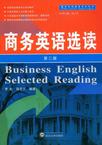商务英语选读
出版时间:2009-1 出版社:武汉大学出版社 作者:罗虹,陆志兴 编著 页数:285
前言
为了适应国际经济形势的变化和满足我国外贸教育发展的需求,此次我们对《商务英语选读》进行了全面的修订和补充,使内容和质量更为充实和完善。 本书修订注重结合英语经贸专业类学生的特点,在编写设计上重点突出国际商务活动相关的内容,增加专业术语和知识。同时,强调对学生英语基本技能的培养和训练,努力提高学生实际运用英语的能力,培养全面发展复合型国际商务人才。 修订和补充的内容有: 1.对个别章节的课文与阅读材料进行更新,使之更具时代性、知识性和趣味性; 2.增补了与每个单元课文相关的语言与文化背景知识; 3.对每个单元课文中难度较大的句式和商务术语补充了解释和翻译。 编写上具有以下几个特点: 题材广泛。本书从国际贸易、金融证券、贸易谈判、商务交际和电子商务等多方面介绍了国际贸易的领域,内容丰富多彩,全面展现了国际商务活动主题的涵盖面,是一本系统、完整的商务英语阅读教材。 材料新颖。本教材所选的内容大部分来源于国内外最新原版书籍和文章,观点新颖、表达地道。在着重介绍商务知识与商务活动的同时,也介绍了语言文化与跨文化交际方面的知识。本书还从构词、句法、中心大意、阅读技巧等方面介绍了如何提高英语阅读理解的系列方法,可帮助学生提高英语阅读的理解能力。 专业突出。本书所用商务词汇术语专业、准确,学生可在学好专业课的基础上,积累商务知识及标准表达法,形成本专业的独特优势。
内容概要
为了适应国际经济形势的变化和满足我国外贸教育发展的需求,此次编者对《商务英语选读》进行了全面的修订和补充,使内容和质量更为充实和完善。本书修订注重结合英语经贸专业类学生的特点,在编写设计上重点突出国际商务活动相关的内容,增加专业术语和知识。同时,强调对学生英语基本技能的培养和训练,努力提高学生实际运用英语的能力,培养全面发展复合型国际商务人才。
书籍目录
Chapter 1 Cross Culture of Business Section I Text A Aspects of Culture ( I ) Reading Passage 1, Passage 2 Section II Text B Aspects of Culture ( II ) Reading Passage 3, Passage 4 Reading Skill PrereadingChapter 2 Business Etiquette Section I Text A Everyday Etiquette for Office Life Reading Passage 1, Passage 2 Section II Text B Handshakes Reading Passage 3, Passage 4 Reading Skill Speed ReadingChapter 3 Insurance Section I Text A Insurance and Its Functions Reading Passage 1, Passage 2 Section lI Text B Types of Insurance Coverage Reading Passage 3, Passage 4 Reading Skill SkimmingChapter 4 Global Corporations Section I Text A Multinationals Reading Passage 1, Passage 2 Section II Text B The Ups and Downs of Sanyo Reading Passage 3, Passage 4 Reading Skill ScanningChapter 5 Successful Businessmen Section I Text A Inspiration and Hard Work Made Me an Entrepreneur Reading Passage 1, Passage 2 Section H Text B Malcolm McLean Reading Passage 3, Passage 4 Reading Skill Context CluesChapter 6 Economy and Business Section I Text A Big-Thinking Chinese HDTV Maker Looks to the U.S. Market Reading Passage 1, Passage 2 Section lI Text B Pepsi Gets Street Smart Reading Passage 3, Passage 4 Reading Skill Main IdeaChapter 7 Advertisements Section I Text A The Advertising Standards Authority:An Advertising Watchdog Reading Passage 1, Passage 2 Section lI Text B Advertising Reading Passage 3, Passage 4 Reading Skill Stems and AffixesChapter 8 Internet and E-commerce Section I Text A Surfing to Success Reading Passage 1, Passage 2 Section II Text B Getting World onto Intemet Train Reading Passage 3, Passage 4 Reading Skill Paragraph Analysis: Reading for Full UnderstandingKeys to ExercisesVocabularyReferences
章节摘录
Todays bills are problematic for vending machines. Modern vending machines accept dollar bills, but users still face the frustration of their money being rejected because of folded corners and wrinkled edges. One of the great benefits of smart cards is that the cards value can be verified and changed without going through the kind of credit card dial-up system. Transactions can be speeded up, and lines shortened. Imagine using the sort of smart card planned by Visa in an experimental program for the 1996 Atlanta Olympics. Although final plans are still being worked out, the user could get up in the morning with a card he had loaded with, say,$ 200 the day before at an ATM-like machine. He pays for breakfast at a fast food restaurant, pays for a bus ride to an Olympic stadium, then purchases a ticket for the pole vault competition at a machine on-site. In the hot afternoon sun, he stops by a vending machine to purchase a cool drink with the card, then pauses at a nearby telephone to call home, also using the card. With the value of the card reduced, he might stop at an ATM to add another $100. (One of the virtues of the card is that if it is lost, only its current value is put at risk, and not an entire line of credit.) Or he might exhaust the cards value and simply throw it away. In the Visa experiment, the cards will be disposable. Converting to smart cards will require massive, but gradual, refitting or replacement of equipment in stores, restaurants, and telephones. The first smart cards will carry the conventional magnetic stripe so they can be used like traditional credit cards in addition to their "smart" functions.The transition will likely be a quiet, almost unnoticed process. And its already happening.
编辑推荐
高等院校商务专业系列教材,21世纪商务人士必备工具书,内容涵盖当今国际商务最新观点、最新动态,帮助您迎接新世纪国际商务业态的新挑战。
图书封面
评论、评分、阅读与下载
